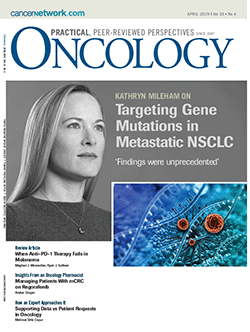Regorafenib for Metastatic Colorectal Cancer: Common Toxicities and Prevention Strategies
An oncology pharmacist discusses how to prevent and treat the toxicities from regorafenib for the treatment of colorectal cancer.
Oncology (Williston Park). 33(4):126-7.

Amber Draper, PharmD, BCOP

Introduction
Regorafenib is a once-daily oral multikinase inhibitor approved for treatment of metastatic colorectal cancer following progression on chemotherapy, anti–vascular endothelial growth factor (VEGF) therapy, or anti–epidermal growth factor receptor therapy.[1] The US Food and Drug Administration approved regorafenib based on the results of the 2012 CORRECT trial, which demonstrated an improvement in overall survival with this agent vs best supportive care in patients with metastatic colorectal cancer (6.4 months vs 5 months, respectively; hazard ratio, 0.77; 95% CI, 0.64–0.94; P = .0052).[2]
The most common grade 3 or higher adverse events associated with regorafenib use are palmar-plantar erythrodysesthesia (PPE; 17%), diarrhea (7%), and hypertension (7%).[2] Most adverse events occur within the first cycle of treatment and decrease over time, suggesting that early recognition and management of drug-related toxicities can increase adherence and treatment duration.[3]
Management of Regorafenib-Associated Toxicities
PPE
The mechanism of PPE is theorized to be a result of dual VEGF receptor and beta-type platelet-derived growth factor receptor inhibition, which interferes with vascular repair mechanisms in high pressure areas exposed to repeated friction or pressure.[3] PPE is most likely to occur within the first 2 to 4 weeks of treatment and can be the most distressing adverse outcome to patients. Affected patients present with prodromal symptoms of dysesthesias in the palms and soles that progress to asymmetrical hyperkeratotic lesions. Lesions can be accompanied by redness, pain, and blisters, and escalation from grade 1 to 3 toxicity occurs quickly with continued dosing.[4]
It is ideal for management of PPE to begin before symptoms appear. Prophylactic measures-such as removal of preexisting hyperkeratotic lesions prior to treatment and assessing the need for orthotic devices in individuals with abnormal weight bearing-should be implemented. Patients can be educated to avoid activities that increase exposure of the hands/feet to heat and friction-such as washing dishes, taking hot showers, and exercising vigorously-and to wear non-constrictive clothing, thick socks, and padded shoes when needed.[3,4]
Non–urea-based creams should be utilized throughout treatment. Most importantly, close communication should be kept with patients during the first 21-day cycle of treatment to ensure compliance and observe for early signs of toxicity. For those with grade 1 PPE, supportive care measures should be reinforced. Treatment for the affected areas includes keratolytic creams containing urea or salicylic acid 6%, along with topical corticosteroids and analgesics if the PPE is grade 2 or higher, with possible dose reductions.[5]
If patients present with grade 3 or higher PPE, regorafenib must be stopped until symptoms resolve (typically within 1 to 2 weeks), and then restarted at a 50% lower dose.[6] Additional toxicities of regorafenib, such as hypertension, diarrhea, and hepatotoxicity, should be assessed within the first month of treatment initiation and then on an ongoing basis.[1]
Hypertension
The overall incidence rate of regorafenib-related hypertension has been reported to be as high as 44%, demonstrating the need for close monitoring and management.[7] Providers should instruct patients to monitor their blood pressure daily for the first 6 weeks of treatment, as in the CORRECT trial. If blood pressure increases, there is no single preferred antihypertensive agent, and selection of therapy should take into consideration the patient’s comorbidities. Diuretics should be avoided due to concern for dehydration in the setting of regorafenib-induced diarrhea. Pharmacologic treatment should be initiated for grade 2 or higher hypertension, and regorafenib should be discontinued if grade 4 toxicity occurs.[5,7]
Diarrhea
Grade 1 or 2 diarrhea has been reported in 34% of patients on regorafenib.[1] As with other toxicities, early management can prevent dose reductions and drug discontinuation. Management of mild-to-moderate diarrhea may include dietary changes, such as implementation of a lactose-free or high-fiber diet, as well as use of over-the-counter anti-diarrhea agents such as loperamide. Patients should be continually assessed and instructed to notify a provider if the number of stools increases by more than three daily, since severe diarrhea can lead to dehydration and electrolyte imbalances.[3]
Dosing Strategies
Although various dosing strategies have been employed in practice to ameliorate toxicities resulting from regorafenib, little data support such approaches. In the ReDOS trial, Bekaii-Saab et al investigated dose titration over the first cycle of treatment to optimize regorafenib dosing. They hypothesized that increasing the dose slowly in weekly increments would reduce adverse events during the first cycle and early discontinuation of therapy.[8]
Patients were randomized to 160-mg regorafenib daily for 21 days or a weekly dose escalation of regorafenib over 3 weeks (80-mg regorafenib daily for week 1, 120 mg daily for week 2, and 160 mg daily for week 3). The patient’s tolerated dose at the end of cycle 1 became the starting dose for cycle 2. Within each treatment group, patients were further stratified to a preemptive strategy vs reactive strategy arm for PPE. The primary endpoint was the number of patients completing cycle 2 at 8 weeks. Secondary endpoints included overall survival (OS), progression-free survival, time to progression, cumulative dose, quality of life (QOL), and safety.[8]
At its conclusion, the study found that weekly dose escalation of regorafenib from 80 mg to 160 mg daily was superior to 160-mg regorafenib daily, with 43% vs 24% of patients, respectively, completing cycle 2 (P = .281). There was a trend for improved OS in the dose-escalation arm (9 months vs 5.9 months; P = .94). At 2 weeks following therapy initiation, the dose-escalation strategy did not appear to compromise QOL, unlike the standard-dose administration. Grade 3 and 4 toxicities were lower in the dose-escalation arm vs the standard-dose arm (PPE, 15% vs 16%; hypertension, 7% vs 15%; and fatigue, 13% vs 18%). The authors concluded that a dose escalation strategy optimizes regorafenib dosing and appears to be better tolerated than standard dosing, with fewer adverse events.[8]
Clinical Implications
The National Comprehensive Cancer Network (NCCN) Colon Cancer Guidelines Version 4.2018 include the dose titration schedule as an option for patients receiving regorafenib for metastatic colorectal cancer.[9] Data regarding the outcomes of preemptive vs reactive PPE prevention strategies are forthcoming.[8] In practice, the dose-escalation strategy may allow for early intervention during the escalation cycle, before drug discontinuation is warranted due to grade 3 or 4 toxicities. Combined with education and supportive measures, patients may be able to maintain treatment and achieve an improvement in OS when the dose-escalation strategy for regorafenib dosing is utilized.
Additional Considerations for Regorafenib Usage
• Although regorafenib has demonstrated an improvement in overall survival in metastatic colorectal patients, many patients discontinue therapy within the first treatment cycle due to adverse events.
• Providers should educate patients about common toxicities associated with regorafenib use, especially palmar-plantar erythrodysesthesia, hypertension, and diarrhea.
• Patient education should include preventative and supportive measures, as well as when to contact the provider.
• Monitoring within the first treatment cycle helps to optimize therapy and to provide an early intervention due to side effects.
• Implementing a dose escalation strategy optimizes dosing, improves overall survival, and results in fewer adverse events.
Financial Disclosure: Dr. Draper has no significant financial interest in or other relationship with the manufacturer of any product or provider of any service mentioned in this article.
References:
1. Drugs@FDA. STIVARGA (regorafenib) tablets, oral. https://www.accessdata.fda.gov/drugsatfda_docs/label/2012/203085lbl.pdf. Accessed March 13, 2019.
2. Grothey A, Van Cutsem E, Sobrero A, et al. Regorafenib monotherapy for previously treated metastatic colorectal cancer (CORRECT). Lancet. 2013;381:303-12.
3. Khan G, Moss RA, Braiteh F, et al. Proactive strategies for regorafenib in metastatic colorectal cancer: implications for optimal patient management. Cancer Manag Res. 2014;6:93-103.
4. Crona DJ, Keisler MD, Walko CM. Regorafenib: a novel multitargeted tyrosine kinase inhibitor for colorectal cancer and gastrointestinal stromal tumors. Ann Pharmacother. 2013;47:1685-96.â©
5. Krishnamoorthy SK, Relias V, Sebastian S, et al. Management of regorafenib related toxicities: a review. Therap Adv Gastroenterol. 2015; 8:285-97.
6. Lacouture ME, Shenhong W, Robert C, et al. Evolving strategies for the management of hand-foot skin reaction associated with the multitargeted kinase inhibitors sorafenib and sunitinib. Oncologist. 2008;13:1001-11.
7. Wang Z, Xu J, Nie W, et al. Risk of hypertension with regorafenib in cancer patients: a systematic review and meta-analysis. Eur J Clin Pharmacol. 2014;70:225-31.
8. Bekaii-Saab T, Ou F, Anderson D, et al. Regorafenib dose optimization study (ReDOS): randomized phase II trial to evaluate dosing strategies for regorafenib in refractory metastatic colorectal cancer (mCRC): an ACCRU Network study. J Clin Oncol. 2018 Feb 26. [Epub ahead of print]
9. National Comprehensive Cancer Network Guidelines. Colon Cancer. Version 4.2018. https://www.nccn.org/professionals/physician_gls/pdf/colon.pdf. Accessed March 13, 2019.

Newsletter
Stay up to date on recent advances in the multidisciplinary approach to cancer.